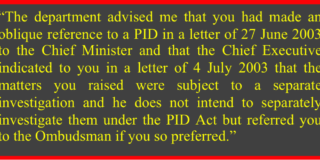”Quite often before they get there [to court] they have done something quite serious. It becomes quite difficult because the offending behaviour is the first point that you’ve got to address and you can’t say that just because someone is Aboriginal they are excused from any criminal behaviour. Clearly that doesn’t work. You have to go back earlier, to why they are offending in the first place.”
Chief Justice Terrence Higgins
Indigenous jail rate appalling, The Canberra Times
On 11 September, 2008 the then Chief Minister Jon Stanhope opened the Australian Capital Territory’s (ACT) own prison, the Alexander Maconochie Centre, although the first prisoners were not transferred there until early 2009. According to Minister John Hargreaves, the prison was built with the human rights of detainees in mind, stating that, “People come to prison as punishment not for it.” More than one lawyer I know would disagree with the former Minister, arguing that the purpose of a prison is to protect the public, with the line of thought being focused upon rehabilitation rather punishment. If an offender poses no physical threat to others, there is no reason to detain him/her behind bars.
More interesting however, is the claim that the prison has been designed with human rights in mind. Those who identify as Aboriginal Australians constitute around 1.5% of the ACT population, yet those in prison make up 15% of the population, with the total on remand comprising 20%. There’s little point in saying any prison focuses on human rights when the justice system itself so blatantly marginalizes the smallest portion of the local population so severely. Whilst the ACT is not alone in such a disproportion within its prison system, for such a recent innovation to the Territory it is of concern that the balance of inmates is already so skewed as to compete with similar statistics in Western Australia, which has a much longer record of prison incarceration.
Indigenous Australians are sometimes seen as belligerent individuals who spurn integration with the wider community. This includes the judiciary who are charged with interpreting the rule of law and the police who are expected to follow the law. Yet, when an indigenous woman is sentenced to three months in a New South Wales prison for benefiting from the proceeds of the sale of a $1.00 raffle ticket, is it any wonder that her companions believe that she has been unjustly punished?
Want a Canberra comparison? Just read Blak and Black, for the evidence is much more damning. Damning because Canberra has repeatedly failed to treat Aborigines as equal.
The Chief Justice’s concern about the disproportionate incarceration of Indigenous people should be viewed against the much touted Human Rights Act 2004 (ACT), created and brought into law by the ACT Legislative Assembly on 2 March, 2004. Section 8 “Recognition and equality before the law” states:
(1) Everyone has the right to recognition as a person before the law.
(2) Everyone has the right to enjoy his or her human rights without distinction or discrimination of any kind.
(3) Everyone is equal before the law and is entitled to the equal protection of the law without discrimination. In particular, everyone has the right to equal and effective protection against discrimination on any ground.
Examples of discrimination:
Discrimination because of race, colour, sex, sexual orientation, language, religion, political or other opinion, national or social origin, property, birth, disability or other status.
These basic tenets are jus cogens and are considered to be of a humanitarian nature, underscoring further basic principles such as the right of access to justice and the prohibition of racial discrimination. Yet, the right of access to justice is precisely what Ms. King has been denied by Australian Federal Police and racial discrimination at the hands of the AFP, Ernst & Young, the ACT Department of Treasury and the ACT Courts has been the burden of Pat, the former Commissioner for ACT Revenue, both of whom identify as Indigenous Australians. Ms. King has suffered not only because of her cultural identity, but also her gender, discriminatory practices specifically prohibited by the ACT’s very own Bill of Rights. It is the abuses meted out to Ms. King and much of that suffered by Pat, delivered after the ACT Bill of Rights was enacted, that prove its complete ineffectiveness to any Aborigine in Canberra.
The disproportionate number of Indigenous Australians incarcerated or on remand in Canberra raises the spectre of significant issues with the justice system in the Australian Capital Territory. Such blatant imbalance in sentencing points to a Territory more intent upon sacrificing Indigenous people than addressing the hardest questions of all – how to break the back of the racism and corruption that festers within the walls of the nation’s smallest independent jurisdiction. That corruption is exemplified by comments such as those made by an ACT prosecutor, who in a fit of hubris commented to an ACT Revenue Office employee that:
“You don’t have to worry about your little boong mate Marky suing you for fitting him up. When I’m finished with him he’ll be in the gutter where he belongs with all his other boong mates. You will be able to piss on him as you step over him on your way to work”
Hardly the words of a public servant who believes he must adhere to the rule of law. It is impossible for one charged with such an attitude to perform a sursum corda, to lift his heart up to the higher ideal underpinning the rule of law, for one so corrupt refuses to see beyond the blinkers of his own discriminatory thoughts patterns.
If truth were to be told and the police, legislators and judiciary were to look critically at the cases of the former Commissioner for ACT Revenue and Ms. King, the irony of these words from Higgins CJ would be obvious:
“…you can’t say that just because someone is Aboriginal they are excused from any criminal behaviour.”
Both Ms. King and Pat were victims of attacks by a racist individual, whose local notoriety and high profile connections protected him from prosecution. What Chief Justice Higgins is stating is that no-one should be above the law. If that is so, then it should be fair to say, “You can’t say that just because someone is a [notable person] they are excused from any criminal behaviour.” This includes those responsible for the physical, psychological and material attacks upon the former Commissioner for ACT Revenue, Ms. King and their families. If the law is to be applied fairly in the ACT, then it must not be simply Indigenous Australians that are put in the spotlight. There must be no exceptions for social position or connections. The former New South Wales Justice Marcus Einfeld is a prime example of the how the law should be applied. A much more notable man could not have suffered a greater mea culpa for what began as such a minor offence. It is high time the ACT justice system delivered a maxima mea culpa to the Inquisitor and his supporting cronies and demonstrated to the rest of the country the true utility of the nation’s first Bill of Rights and its genuine desire to adhere to the rule of law.



ACT Bill of Rights, a big bag of lies.